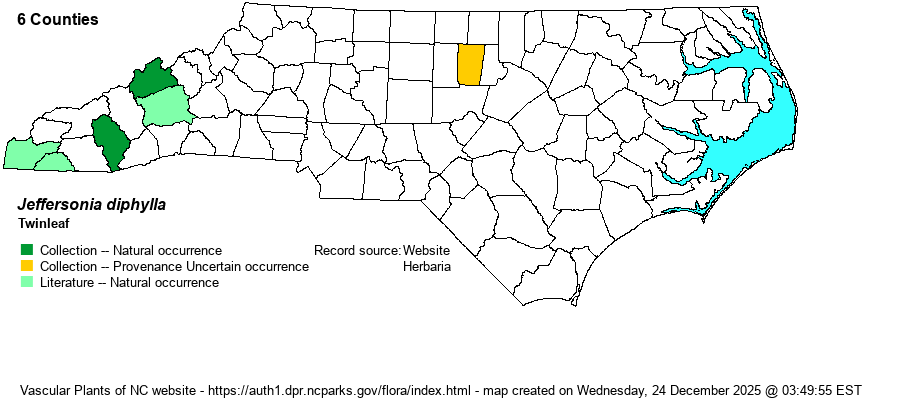| Author | (L.) Persoon | |
| Distribution | Known from just a few sites in the Mountains: specimens from Madison and Jackson counties, and iNaturalist photos from Buncombe, Clay, and Cherokee counties (if these are at natural sites). A specimen in SERNEC from Watauga County is plausible (Junaluska Road, 6 miles W of Boone), but it lacks an image. This scarcity in NC is surprising, considering its widespread occurrence in eastern TN and in southern VA, well eastward into that state's Piedmont. However, this is a very obvious species, and this dichotomy is real; it is not being overlooked in NC.
This is a mostly Mideastern species, ranging from NY west to southeastern MN, and south to central AL. | |
| Abundance | Very rare in the Mountains, known from just a handful of sites, despite a relative abundance of very rich forested slopes with high pH soils. It was first discovered in Jackson County in 1933, in Cullowhee; it was re-discovered in Cullowhee in 1992, though it is not clear if the two locations are the same. The Madison County site was discovered in 2007. The iNaturalist photos are in the last few years, certainly extant (if natural). This is a State Threatened species. | |
| Habitat | This species requires very high pH soil, of cove forests over mafic or calcareous rocks. The NC sites seem to be over calcareous rocks. |
| Phenology | Blooms in March and April, and fruits in May. | |
| Identification | This is a striking spring wildflower, but sadly you must travel out of state to have a reasonable chance to see it, as it is not scarce in VA or TN. When it starts to flower, the single leaf is held only about 6 inches off the ground, but after flowering it can reach 1.5 feet tall. The leaf blade is unusual, in that it is essentially divided in half, to yield 2 elliptical or ovate segments that are wavy-edged to barely notched. Each segment is about 2-3 inches long and half as wide, but after flowering is almost twice the size. The separate flowering stalk is about 8 inches tall at first, barely above the leaves; the single flower is white, usually with 8 narrowly elliptical petals and a spread of 1.5 inches across. The very odd leaf, divided into two ovate segments barely connected in the middle, looks like no other species; the only other member of the genus grows in eastern Asia. Only remotely similar, at least in the flower, is Sanguinaria canadensis, but that species has a fan-shaped leaf with numerous fingers and not divided into two sections. | |
| Taxonomic Comments | None
| |
| Other Common Name(s) | American Twinleaf | |
| State Rank | S1 | |
| Global Rank | G5 | |
| State Status | T | |
| US Status | | |
| USACE-agcp | | |
| USACE-emp | | |

